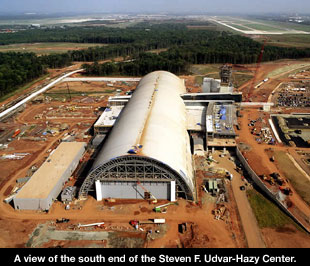|
|

|
Air and Space annex 75 percent complete
December 1, 2002 — Gen. Jack Dailey, Director of the National Air and Space Museum, announced November 20 that construction to open the Steven F. Udvar-Hazy Center was three-fourths complete toward the December 2003 launch of the museum's Virginia companion facility.

The center at Dulles International Airport will eventually present 80 percent of the Smithsonian's collection not currently displayed at the museum's flagship building on the National Mall in Washington, DC or on loan to other organizations.
Construction of the Udvar-Hazy Center began in 2001 with thrust blocks formed to support the 10-story arched trusses of the facility's centerpiece aviation hangar. The last of the 21 trusses was erected in May of 2002; the outer surface was fully in place by August; the huge hangar doors on the north and south ends were installed in September; and the pouring of the concrete floor — nearly three football fields in length — began in October.
The first phase of the center also includes the James S. McDonnell Space Hangar, named for the late aerospace executive; the 164-foot-tall Donald D. Engen Observation Tower, named for the museum's late director; the Claude Moore Education Center, named for the philanthropist; an IMAX theater; and a food court.
Foundation work for the McDonnell Space Hangar began in August 2002. The tallest piece of steel at the center — for the top of the Engen tower — was lifted into place on September 25. The theater roof was in place at the start of October. With completion of the first phase, the facility will encompass 523,000 square feet of space.
A second phase of construction, including a restoration hangar, archives, conservation lab, collection processing facilities and a study collections storage unit is planned, with the start date for construction dependent on fund raising. The entire facility will be approximately 760,000 square feet. No federal funds are being used to build the Udvar-Hazy Center.
The architecture alone would draw crowds from all over but combine this facility with our unparalleled collection and you've got an unbeatable attraction," said Dailey. The flow of artifacts into the center will begin early next year and continue beyond opening day in a complex process of arranging uniquely shaped and sized aerospace items.
Most of the air and spacecraft will be moved from the museum's Paul E. Garber Preservation, Restoration and Storage Facility in Suitland, Maryland. This includes the museum's Curtis P-40E Warhawk, the Lockheed 5C Vega Winnie Mae and the Boeing B-29 Superfortress Enola Gay. Other artifacts such as the SR-71 Blackbird will be moved from hangars on the airport grounds. Because of preparations for the Udvar-Hazy, tours of Garber will end in March 2003. The facility opened to the public in 1977.
Two other well-known aircraft headed for the Udvar-Hazy Center — the Boeing 307 Stratoliner, the only surviving example of the first pressurized commercial airplane and the Dash Eighty, the original prototype for the 707 jetliner — will be flown to Dulles next summer from storage in Seattle. A towpath linking a nearby runway to the center has already been paved.
The Udvar-Hazy Center will be the final destination for some 200 aircraft and 135 large space artifacts. For the December 2003 opening, some 70 airplanes will be in place — more than on display now at the museum on the Mall. The shuttle Enterprise, stored at Dulles since 1985, will be exhibited on opening day as the centerpiece of the Space Hangar, where it will later undergo refurbishment.
Next month at the museum on the Mall, visitors will be able to preview one of 10 Udvar-Hazy exhibition stations that will provide broad historical context for the center's aircraft and large space artifacts. The exhibit stations will present historic themes using large graphic panels and customized cases containing uniforms, memorabilia and other smaller pieces from the national collection.
Feedback from previewing the Pre-1920 Aircraft: When Wings Were New station will help museum curators and designers with planning for future center displays at the Udvar-Hazy Center.
The museum's education office has already received some 400 applications for volunteer docent positions at the Udvar-Hazy. Screening will begin next February for candidates selected to give tours and welcome visitors. High school and college students are also being recruited for the Explainers Program that will conduct educational demonstrations in the facility and surrounding community. A "Teachers in Residence" pilot program is also under development that will bring in full-time teachers from the local school districts to develop curriculum and organize field trips to the facility.
The Udvar-Hazy Center is being built by Hensel Phelps Construction, an employee-owned company based in Greeley, Colorado, and its Mid-Atlantic regional office located in Chantilly, Virginia. The Smithsonian awarded the Udvar-Hazy contract to Hensel Phelps in April 2001.
The Commonwealth of Virginia is providing infrastructure. The Virginia Department of Transportation is overseeing contracts for site clearing, roadways, utilities, paving and related work. VDOT also transferred funding for wetlands mitigation required by the U.S. Army Corps of Engineers. That work will be overseen by the Smithsonian Institution at Manassas National Battlefield Park in an exchange for the conversion of wetland areas at the Udvar-Hazy site.
The December 2003 opening of the Udvar-Hazy will mark the 100th anniversary of the Wright brothers' first flight. |
back to News

© 2023 collectSPACE.com All rights reserved.
Questions? E-mail [email protected]

|
|

|

|
